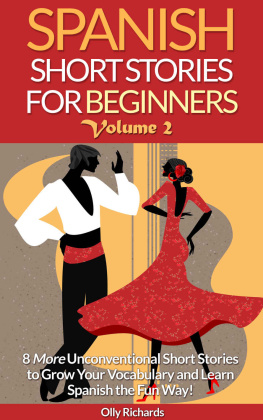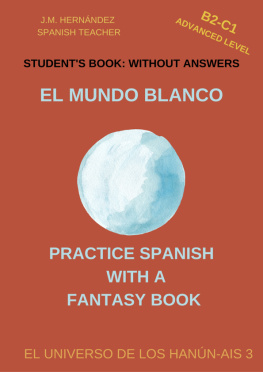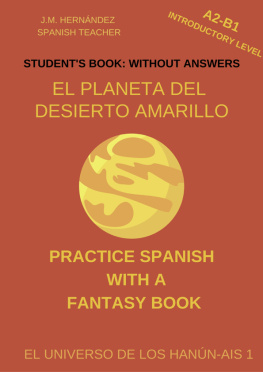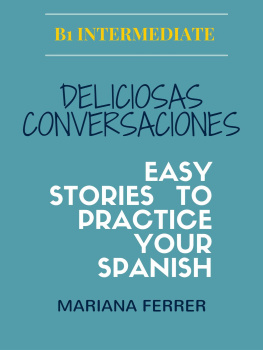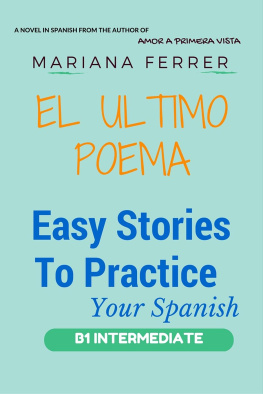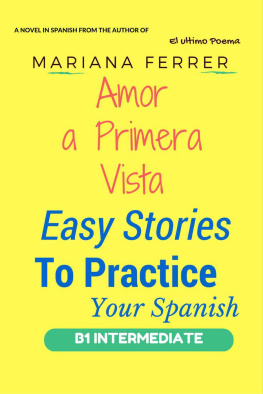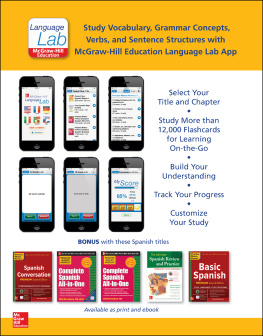CLIMATE CHANGE IN SIMPLE SPANISH
Learn Spanish the Fun Way With Topics That Matter
For Low- to High-Intermediate Learners (CEFR B1-B2)
by Olly Richards
Edited by Eleonora Calviello
Gianluca Trifirò, Academic Editor

Copyright © 2020 Olly Richards Publishing Ltd.
All rights reserved. No part of this publication may be reproduced, distributed, or transmitted in any form or by any means, including photocopying, recording, or other electronic or mechanical methods, without the prior written permission of the publisher, except in the case of brief quotations embodied in critical reviews and certain other non- commercial uses permitted by copyright law. For permission requests, write to the publisher:
Olly Richards Publishing Ltd.
Trademarked names appear throughout this book. Rather than use a trademark symbol with every occurrence of a trademarked name, names are used in an editorial fashion, with no intention of infringement of the respective owner’s trademark.
The information in this book is distributed on an “as is” basis, without warranty. Although every precaution has been taken in the preparation of this work, neither the author nor the publisher shall have any liability to any person or entity with respect to any loss or damage caused or alleged to be caused directly or indirectly by the information contained in this book.
Climate Change in Simple Spanish: Learn Spanish the Fun Way With Topics that Matter
Free StoryLearning® Kit
Discover how to learn foreign languages faster & more effectively through the power of story.
Your free video masterclasses, action guides & handy printouts include:
- A simple six-step process to maximise learning from reading in a foreign language
- How to double your memory for new vocabulary from stories
- Planning worksheet (printable) to learn faster by reading more consistently
- Listening skills masterclass: “How to effortlessly understand audio from stories”
- How to find willing native speakers to practise your language with
To claim your FREE StoryLearning® Kit, visit:
www.storylearning.com/kit

WE DESIGN OUR BOOKS TO BE INSTAGRAMMABLE!
Post a photo of your new book to Instagram
using #storylearning and you’ll get an entry
into our monthly book giveaways!
Tag us @storylearningpress to make sure we see you!
ABOUT THE AUTHOR

Olly Richards is a foreign language expert and teacher. He speaks eight languages and has authored over 30 books. He has appeared in international press, from the BBC and the Independent to El País and Gulf News. He has featured in language documentaries and authored language courses for the Open University.
Olly started learning his first foreign language at the age of 19, when he bought a one-way ticket to Paris. With no exposure to languages growing up, and no natural talent for languages, Olly had to figure out how to learn French from scratch. Twenty years later, Olly has studied languages from around the world and is considered an expert in the field.
Through his books and website, StoryLearning.com, Olly is known for teaching languages through the power of story – including the book you are holding in your hands right now!
You can find out more about Olly, including a library of free training, at his website:
www.storylearning.com
INTRODUCTION
I have a golden rule when it comes to improving your level and becoming fluent in a foreign language: Read around your interests. When you spend your time reading foreign language content on a topic you’re interested in, a number of magical things happen. Firstly, you learn vocabulary that is relevant to your interests, so you can talk about topics that you find meaningful. Secondly, you find learning more enjoyable, which motivates you to keep learning and studying. Thirdly, you develop the habit of spending time in the target language, which is the ultimate secret to success with a language. Do all of this, and do it regularly, and you are on a sure path to fluency.
But there is a problem. Finding learner-friendly resources on interesting topics can be hard. In fact, as soon as you depart from your textbooks, the only way to find material that you find interesting is to make the leap to native-level material. Needless to say, native-level material, such as books and podcasts, is usually far too hard to understand or learn from. This can actually work against you, leaving you frustrated and demotivated at not being able to understand the material.
In my work as a language educator, I have run up against this obstacle for years. I invoke my golden rule: “Spend more time immersed in your target language!”, but when students ask me where to find interesting material at a suitable level, I have no answer. That is why I write my books, and why I created this series on non-fiction. By creating learner- friendly material on interesting and important topics, I hope to make it possible to learn your target language faster, more effectively, and more enjoyably, while learning about things that matter to you. Finally, my golden rule has become possible to follow!
Climate Change
If there is one issue that has come to define our times, it is climate change. From classrooms to building sites, office buildings to car showrooms, climate change has become an issue that millions of people around the world are taking more seriously than ever. More and more, people are choosing to educate themselves on what they see as the most important issue of their lives. So, what better way to improve your Spanish than to learn about climate change… in Spanish?
Climate Change in Simple Spanish is the ideal companion for climate-conscious learners to improve their Spanish.
Not only will you learn the vocabulary you need to talk about climate change in Spanish, but you will also deepen your knowledge about climate change itself. Written in a fun conversational format that makes the science easier to understand, you’ll follow discussions between three main characters over 34 chapters as they discuss the main issues of climate change. Fun, comprehensive, apolitical, and reviewed at PhD level for scientific accuracy, this book is the perfect way to improve your Spanish while learning about the most important issue facing our planet today.
HOW TO USE THIS BOOK
There are many possible ways to use a resource such as this, which is written entirely in Spanish. In this section, I would like to offer my suggestions for using this book effectively, based on my experience with thousands of students and their struggles.
There are two main ways to work with content in a foreign language:
1. Intensively
2. Extensively
Intensive learning is when you examine the material in great detail, seeking to understand all the content – the meaning of vocabulary, the use of grammar, the pronunciation of difficult words, etc. You will typically spend much longer with each section and, therefore, cover less material overall. Traditional classroom learning generally involves intensive learning.
Extensive learning is the opposite of intensive. To learn extensively is to treat the material for what it is – not as the object of language study, but rather as content to be enjoyed and appreciated. To read a book for pleasure is an example of extensive reading. As such, the aim is not to stop and study the language that you find, but rather to read (and complete) the book.



